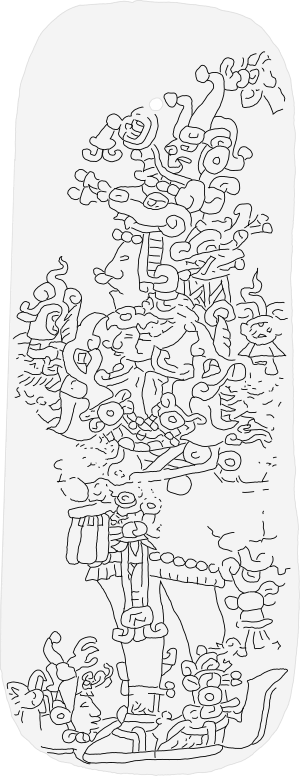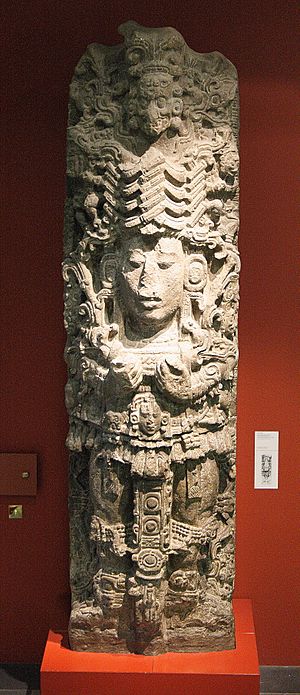Maya belt plaques facts for kids
Imagine ancient Maya rulers wearing special jewelry to show their power! Maya belt plaques were cool, decorative pendants. They hung from the belts of important Maya leaders, called ajawob. These plaques helped show everyone that the ruler was truly in charge. They often showed powerful gods or important ancestors. You can see these plaques in old Maya artwork, like on tall stone carvings called stelae. Rulers wore them during special ceremonies to remember big events and important dates.

What Were Maya Belt Plaques Made Of?
Most belt plaques were carved from a special green stone called jadeite. This stone was very valuable to the Maya people. It was precious because it had to be brought from far away. Jadeite was often traded from the Motagua River area in Guatemala. This made it a rare and highly prized material.
Each plaque had two sides. One side showed a beautifully carved picture of a ruler. This ruler was usually facing left. The other side had a double column of hieroglyphic writing. These carvings explained what the plaque meant. They often showed rulers at their inauguration, which is when they officially took power. The plaques also marked important calendar dates. They could also show worship of ancestors or gods.
Famous Examples of Plaques
The most famous example of a Maya belt plaque is the Leiden Plaque. People sometimes call it the Leiden Plate. It was found in 1864 in a place called Bahia de Graciosa in northern Guatemala. It got its name because it is now kept in the National Museum of Ethnology in Leiden, Netherlands.
This plaque is from the Early Classic period of Maya history. Experts believe it originally came from the central lowlands of the Petén Basin in Guatemala. More specifically, it might have come from the famous Maya city of Tikal. The Leiden Plaque is very important to archaeologists. It has one of the earliest known Maya hieroglyphic writings. This helps us understand ancient Maya history better.
You can also see Maya belt plaques in the clothing of Maya ajawob (rulers) on the tall stone carvings called stelae. These stelae are found at ancient sites like Copán in Honduras. They show how important these plaques were to the rulers.


